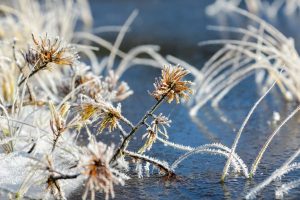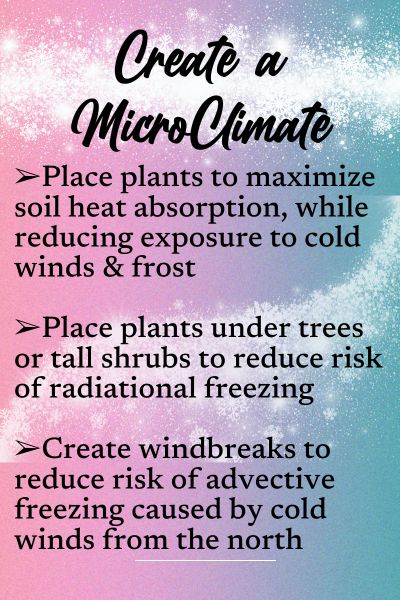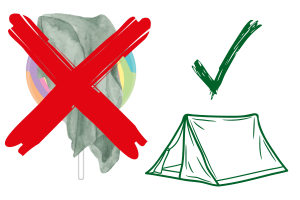 Gardening in Wild Winter Weather
Gardening in Wild Winter Weather
By Becky Wern, MGV
How are you enjoying life on the Northeast Florida weather rollercoaster? Our temperatures go up and down from warm to chilly to freezing. We have lots of sunny, blue-sky days, and a number of rainy days.
The cold may come as a surprise to some newcomers to our area. But there have been years when we have seen snow or ice here. We live in a transitional area. We are not South Florida. We are not “up North.” While our climate is warming, one thing we can count on in the winter is that the weather is pretty variable. Within a week, our winter temperatures can range from 80 degrees to 32 degrees and back again. That is very hard on our plants. Even those that are adaptable. We need to plan for wild winter weather.
While it is tempting to invest in tropical plants in the summer, it might be good to remember that winter will come. That is so hard to do when the beautiful tropical blooming plant is in the nursery!
Where to Position Plants
When winter blasts roll in, they come in from the northwest. Positioning plants on the southeast side of your house can protect them to some extent from the cold winds that come in – there are usually a few degrees of difference between the northwest and northeast sides of the house. Like it or not, our houses leak heat, which can benefit our outdoor plants in winter.
We have two kinds of cold that arrive here. One is advective. It arrives with a rapid drop, usually with windy weather. I won’t forget the year the temperature plummeted to a windy 9 degrees in my Southside yard, quickly. (1985) It was shocking for me and my plants. A couple of years ago, we had a wind blast that flipped my anchored temporary greenhouse on Christmas eve at 1 AM scattering my few orchids and other tender plants into the darkness. While we had an alarm and gathered the plants immediately, even 10 minutes in a freeze is enough to kill tender plants.
Radiational Cold
Cold can also come calmly, and that’s called a radiational cold front. In that case, the skies are clear. Our heat just radiates up into the atmosphere.
When temperatures drop below 45 degrees, tropical plants are likely to be damaged. Some less tropical plants adapt to cold weather. This is especially true if the weather leading up to the cold has been cool, allowing the plant to change its’ sap chemistry.
Some people don’t like our rainy days but when they come before a cold snap, the extra water is very helpful for the plants. The well hydrated roots help plants survive the cold. If we don’t get rain 24 hours before a cold snap, water your plants. Many other factors are involved in a plant’s ability to withstand cold. Some of them you can help your plants control. Some you can’t.
The factors affecting a plant’s hardiness in the cold include
- maturity,
- health,
- stress,
- habitat,
- species, and
- genetics.
Make sure you are planting winter hardy plants at this time of the year. Arugula and salad greens will thrive in January-February. Tender tomatoes will need to wait indoors.
Healthy
Keeping your plants healthy means watching for pests and treating them appropriately if there are problems. Applying nutrients as fertilizers at the right times and not excessively keeps plants growing healthily. And not applying them too late is important, which can keep the plant growing long after it should be entering dormancy. Dormancy protects plants in winter. Doing these things helps protect your plants from stress.
Stress
Stressed plants attract insect pests which sometimes carry diseases. The plants you grow year-round should be dormant right now. If you have planted vegetables and blooming winter annuals, those are the only things that should be actively growing now. Winter temperatures do not deter all pests.
Habitat
Some of this requires that you get to know your habitat, and the species of plants you are buying. Does your yard stay dry or wet after a rainfall? How is your soil? Is it rich or just sandy? Are your plants in full sun or in shade? It’s actually a lot of work to plant an area. But if you are willing to go the extra mile, you can establish a winter hardy and beautiful garden.
Proper covering of tender plants is essential to protect them. Never lollipop them. Tent them. Plants do not generate heat. The heat is rising from the ground, and you want to trap it as it rises and capture it around your plant. You can use cloths or frost cloth. Mulch is great to protect roots and retain moisture.
You are your garden’s designer and protector. It’s the beginning of a new year. Challenges? Sure, we have them…but we have so many possibilities! Unlike our Northern neighbors, we have possibilities all year long. Have fun!
Other Resources
How to prepare for a winter weather event.
How to protect blueberries from the cold
Note: All images and contents are the property of UF/IFAS.





